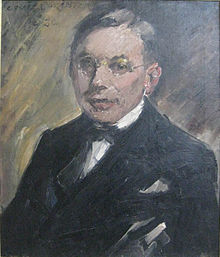Ernst Oppler

Ernst Oppler (9 September 1867 –1 March 1929) was a German Impressionist painter and etcher born in Hanover.
Early life

Ernst Oppler was the son of Edward Oppler, a prominent German-Jewish architect. He studied at the Academy of Arts in Munich under Nikolaus Gysis and Ludwig von Löfftz. Afterwards he moved to London to study the work of James Abbott McNeill Whistler, one of his favorite artists. He became a member of the International Society of Sculptors, Painters and Gravers in 1898. His early work was naturalistic in approach. In 1901 he went to the Netherlands to practise the pleinair method, and painted elegant portraits of the gentry in subdued tones.
Berlin Secession

Oppler was a member of the Munich Secession, but became more active as one of the founders of the Berlin Secession, a group of artists who championed the new, Impressionist style. Oppler moved to Berlin in 1904, and became there a renowned portraitist, and also chronicled daily life through his drawings, etchings, painted cityscapes and genre scenes. With his brother the sculptor Alexander Oppler they had studios in their own Villa Oppler. Ernst Oppler was invited seven times to the Venice Biennale and participated six times.
In 1912 after controversies about expressionism he stopped participating in the exhibitions of the Berlin secession but he still remained one of the most prominent members of the avantgarde. The German state bought works from Oppler and exhibited them in museums as examples of the new wave in art. Oppler started to visit dancing performances of the Russian ballet which was very popular at that time and began to document the performances. He became also an important chronicler of the history of ballet in Germany.
Ernst Oppler died in Berlin on 1 March 1929.
Works
In Germany works by Ernst Oppler are on display at the National Gallery Berlin, the Neue Pinakothek in Munich, the Lower Saxony State Museum and others. Outside of Germany, his works are found in the Foosaner Art Museum, the Harvard Art Museums, the San Francisco Museum of Modern Art, the Brooklyn Museum, the Tel Aviv Museum of Art, the Israel-Museum, the Ateneum in Helsinki, the Museum of Modern Art in Venice and others.
Gallery
-
At the Beach, oil on canvas, 1910-12
-
Three Girls in the Access Balcony, oil on canvas
-
The Painter and Jo, oil on canvas, 1928
-
Ballet, oil on canvas
-
Ballet Dancer, print
-
Tennis, etching, ca. 1920
Further reading
- Jochen Bruns: Ernst Oppler 1867-1929 : mit zwei Werkkatalogen, 1997






